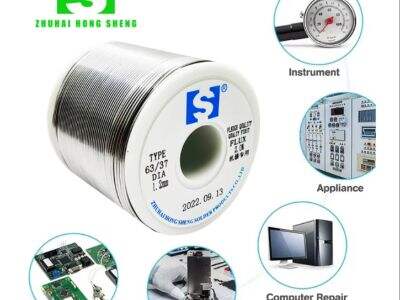There are a variety of types of solder material used on soldering work. The two most common ones are solder wire and paste solder. Both have benefits and drawbacks, and hence the need to comprehend the difference between them. It will guide you to choose the best for your particular project and requirement.
Past solder vs. wire solder
silver solder paste is a solder and flux mixture which is really thick, which you get in a paste consistency. Great for using to make small and finicky solder points, especially for when soldering small components. Solder paste is ideal for finer work, like making jewelry or repairing small electronics. It gives you the precision, because you can be so precise with where you put it, along the seam where you need it. But yet, the paste solder is a little higher in price than wire solder. And it may not be the best choice if you are doing a larger project where you're going to solder over and over again. Wire solder, on the other hand, is a thin wire you can cut to fit. When you solder, you heat the wire on the point of joining. Wire solder is highly pliable and can be used for any kind of project like plumbing and metalworking. It's generally less expensive than paste solder most of the time, that's why it's popular. Still, with tin wire solder, at times it is more difficult to control so specifically, particularly while doing fine detail or extended work. Everything About soldering cutter : Choosing A Material for Your Application
Plan first before moving ahead and solder whatever you'd like to solder. Try and think about just how precise the work is going to be. Paste solder is most likely going to be your best option if you're soldering small, delicate pieces together, as precise application is the utmost priority. Yet if you're dealing with larger joints that won't need that sort of precision, then core wire solder can be an easier and a better one to use.
Paste and wire soldering process
It involves applying a small amount of paste on the joint you are working with when you use paste solder.
You then heat it using a soldering iron. The temperature melts the solder and spreads into the joint. Solder paste includes flux added to the solder which allows the solder to spread and form a solid joint between parts. But the process is a bit different for wire solder. The soldering iron heats on your behalf to melt the wire on the joint itself. It needs more skill and experience in handling the solder when it melts and you have to create a clean solid joint. Advantage Of paste Solder Processes in Highly Detailed Work
For detail slow work, lead paste solder is most commonly best. As it is in paste form, you can apply the solder just where you require it, no wastage & mess. The paste flux allows the solder to bond & cleanses the joint so there's good adhesion. Paste solder ensures little pieces solder well & cleanly.
Project: Wire Solder Application
As a thin solder wire, you can apply it to any number of soldering projects.
It is a wire form so fine, you can cut it to size and adhere to the joint you are repairing. This is especially good for bigger joints that would require a stronger bond. This handy DIY product is applied to everything from plumbing to metalwork to other do-it-yourself repairs. Wire solder lets you have control of the quantity of solder you're using, and you can clip off the excess solder and utilize it as you need on your project.
 EN
EN
 AR
AR
 FR
FR
 DE
DE
 RU
RU
 VI
VI
 TH
TH
 TR
TR
 MS
MS
 BE
BE


